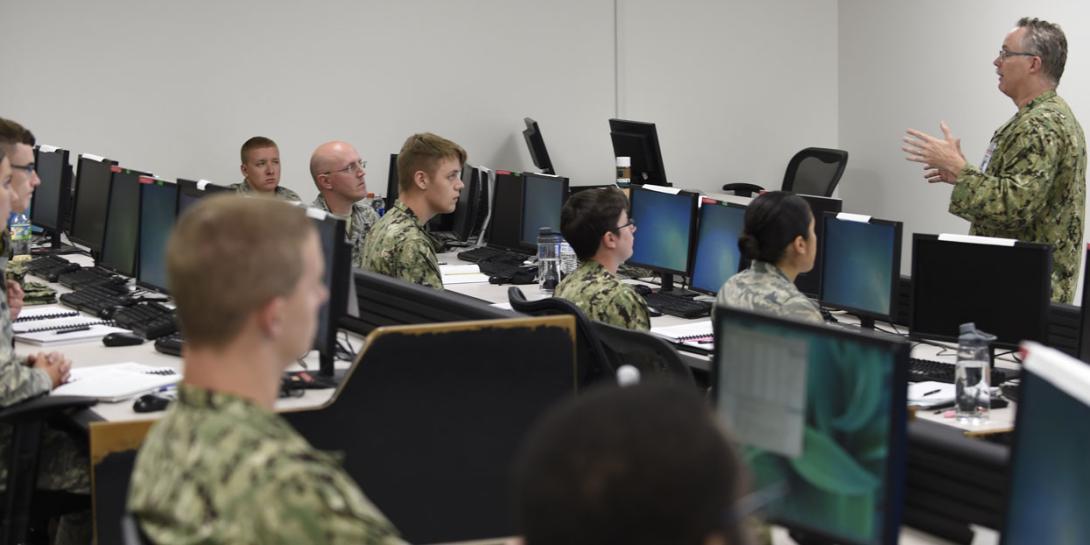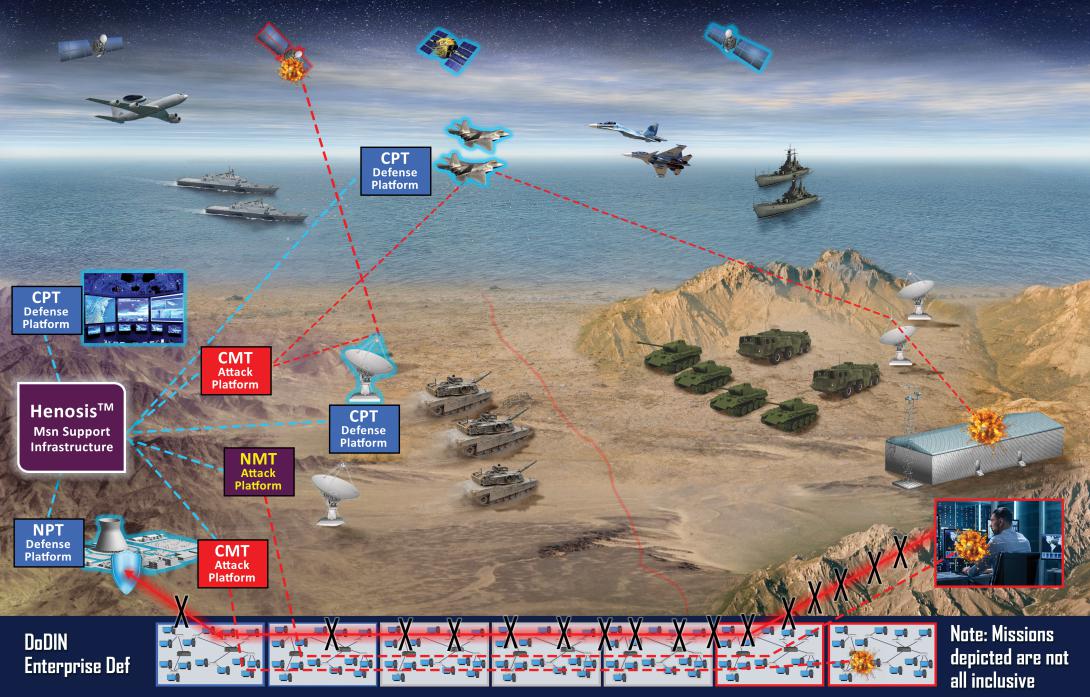Unified Platform Unifies Cyber Warfighting
The U.S. Defense Department is leaning forward by investing in capabilities that equip U.S. cyber forces with a warfighting platform to achieve, maintain and defend cyberspace superiority. The Unified Platform will be critical to realizing U.S. Cyber Command’s vision to maneuver globally and seamlessly between defense and offense across the cyberspace domain and defend far forward into an adversary’s cyber space.
The United Platform (UP) will be a linchpin in the significant advancement in the command’s ability to function with the speed, agility and precision that it requires to counter threats. It will be the “engine room” of the command’s evolving Military Cyber Operations Platform that enables the global synchronization, integration and execution of many missions and functions.
The president’s fiscal year 2019 budget identifies $29.8 million for initial UP development and prototyping. In concert with Cyber Command and all the services, the Air Force as executive agent is directing development and deployment of the platform to ensure timely and relevant full-spectrum capabilities for the department’s cyber warriors.
According to the president’s budget, the first iteration of the platform delivers a minimally viable product that integrates existing cyber capabilities from the military services with the eventual goal of a flexible, interoperable and scalable global cyber warfighting platform. The requirements also call for the use of agile software development and an open architecture to make software configuration changes and updates easily, and provide maximum flexibility for the insertion of new or modified cyber operations capabilities such as sensors, analytics, and offensive and defensive tools.
Former Commander of U.S. Cyber Command and director of the National Security Agency Adm. Michael Rogers, USN (Ret.), explained these capabilities support requirements to Congress when he testified in February. “Our adversaries have grown more emboldened, conducting increasingly aggressive activities to extend their influence without fear of significant consequence. We must change our approaches and responses here if we are to change this dynamic.”
In late March 2018, the Cyber Command unveiled its updated vision statement titled “Achieve and Maintain Cyberspace Superiority,” a much more aggressive and forward-leaning assessment than Adm. Rogers’ 2015 vision statement. Adversaries are executing direct and continuous cyber operations against the United States and its allies just below the level of warfare in campaigns aimed at harming U.S. interests and achieving a competitive advantage over the United States, the new vision emphasizes.
To address this growing number of cyber threats, the command’s latest vision document calls for a new approach. Key to this strategy will be the ability to increase speed; improve maneuvering capabilities to counter cyber adversaries especially in nations such as Russia, China, North Korea and Iran; and secure Defense Department networks, platforms and data.
The 2018 vision stresses that “the United States must increase resiliency, defend forward as close as possible to the origin of adversary activity and persistently contest malicious cyberspace actors to generate continuous tactical, operational and strategic advantage.” The goal is to achieve cyberspace superiority by relentlessly engaging and contesting adversaries below the level of armed conflict unless there is armed conflict.
The UP concept was first mentioned publicly in the 2015 Department of Defense Cyber Strategy. “On the basis of planning requirements,” the strategy states, “DOD will develop the detailed requirements for integrating disparate cyber platforms and building an interoperable and extendable network of cyber capabilities. This Unified Platform will enable the [Cyber Mission Forces] CMF to conduct full-spectrum cyberspace operations in support of national requirements.” Three years later, after much thought by Cyber Command and its service components in developing the operational requirements for UP, the department released the draft UP request for proposal.
As the common cyber interface, current designs for UP meet these requirements while allowing for diversity and flexibility in operations. The platform will enable national and regional members on the cyber teams to work in unity, while optimizing Defense Department operations and prioritizing the flow of resources among combatant commands across the globe.
In addition, the platform will provide command and control, decision support capabilities, operational-to-tactical cyber mission planning, large data ingestion and enhanced analytics. Most importantly, the platform will give the CMF teams the ability to execute synchronized full-spectrum cyberspace operations, including defensive, offensive, and surveillance and reconnaissance operations as well as the enabling support functions.
The CMF teams comprise active duty, reserve and civilian personnel from each branch of the military and U.S. Coast Guard. The 6,200 members of this elite force are organized into 133 teams across the Cyber National Mission Force and combatant commands as well as the Joint Force Headquarters–Department of Defense Information Networks.
The CMF consists of 13 national mission teams focused on defending the United States against cyber attacks of significant consequence and 68 cyber protection teams to defend priority defense department networks and systems against priority cyber threats. It also includes 27 combat mission teams to provide support to combatant commands by integrating cyberspace effects into operational and contingency plans, and 25 support teams that provide analytic and planning support to the national mission and combat mission teams.
In addition to the CMF teams, Cyber Command is in the process of standing up Cyber Operations Integrated Planning Elements (CO-IPEs) with up to 40 cyber warriors at each of the combatant commands. Their mission will be to plan, synchronize, integrate and deconflict cyberspace operations with combatant command plans and operations. They will directly support combatant commanders; the Cyber Command’s Service Cyber Components will retain administrative control.
The CO-IPEs will reach full operational capability within the next five years with the current focus on standing up the elements at U.S. Pacific Command and U.S. Central Command. Additionally, Cyber Command recently opened its Integrated Cyber Center and Joint Operations Center, which provides advanced command, control and integration capabilities. UP is expected to extend capability to these elements as well.
The Cyber Command will require global and rapid command and control capabilities to execute cyber operations, a common operational picture for situational awareness about the health of Defense Department networks and platforms, and data to recognize incoming cyber threats. In addition, the command will need tools that enable the United States to operate inside an adversary’s decision-making loop.
To conduct defensive cyber operations, Cyber Command needs to ingest large amounts of open-source, unclassified and multilevel secret data from its own network and allies’ networks. Quick and actionable joint analytics that identify, halt and mitigate cyber intrusions and attacks also are critical.
For offensive operations, the command needs visibility into the cyber threats as well as cyber capabilities that plug into UP to deliver cyber effects against adversaries and achieve desired U.S. outcomes that support combatant command and national objectives.
Based on the current volume and velocity of cyber threats, it’s clear Cyber Command requires more capabilities now. The command’s 133 teams will be fully staffed by this summer. They require integrated platforms, systems, cyber “bullets,” architectures and training environments that offer capabilities to accomplish their mission. The CMF teams can be filled with cyber soldiers, sailors, Marines, airmen and Coast Guardsmen, but personnel alone don’t make them a ready and capable force.
Headquarters Air Force spokesperson Capt. Hope Cronin, USAF, says UP will significantly enable and allow for the integration and interconnectivity of the CMF. The Air Force Life Cycle Management Center, as the system integrator, will lead a multicontractor, agile development/operations effort to launch and expand from an initial baseline capability. Current efforts also are underway to review and consolidate existing service and Cyber Command platforms.
“Overall, the UP will provide the Cyber Mission Force with a federated capability to prosecute full-spectrum cyberspace operations. Linking operational and tactical levels of warfare, the Unified Platform will deliver flexible, interoperable, survivable and scalable warfighter capabilities that enable mission planning, data analytics, decision support and the execution of offensive and defensive cyberspace operations,” Capt. Cronin says.
Some Cyber Command leaders would have preferred to call the Unified Platform the Unifying Platform. They say this terminology would better illustrate its purpose and design because the platform is the common core that will unite all types of disparate service cyber capabilities. It also will enable connectivity to multiple information networks; provide ready access to volumes of stored data; and provide unprecedented analytical processing power. Conceptually, it is the fabric and foundational enabler that will act as the back office for global cyber planning and operations.
Lockheed Martin has been working on an UP prototype and recently revealed it during a Media Day in March. The prototype is called “Henosis” because it is designed to create unity and oneness among Cyber Command’s globally dispersed command organizations.
Maj. Gen. Jim Keffer, USAF (Ret.), is the director of cyber for Lockheed Martin, Arlington, Virginia. He served as an intelligence officer and retired as the chief of staff for U.S. Cyber Command. Col. David Hathaway, USAF (Ret.), is a business development lead for Lockheed Martin cyber solutions. He served as a fighter pilot and airpower strategist and retired as the director of operations and plans for Air Force Cyber. Lt. Col. David Weissmiller, USAF (Ret.), is a senior cyber architect for Lockheed Martin. He served 23 years as a space and cyber operations officer and helped shape today’s U.S. Defense Department cyber mission.








Comments